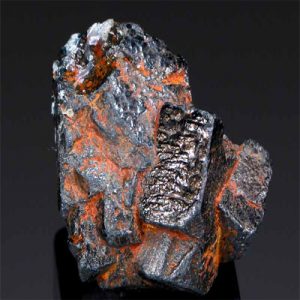Thorianite
Thorianite is a rare thorium oxide mineral that is strongly radioactive due to its throium content. It is more stongly radioactive than Thorite, another thorium mineral that contains both thorium and uranium. Thorium was originally discovered by Ananda Coomaraswamy in 1904 as Uraninite, but recognized as a new species by Wyndham R. Dustan. Thorianite is a rare mineral, but an even rarer as a faceted gem. Thorianite is usually black with a submetallic luster and Mohs hardness of 6.5 – 7.0.
Thorianite is mainly for collectors of rare and unusual gems, black gems or radioactive gems. Thorianite is a highly radioactive mineral and should be stored away from other minerals and gems that might be damaged by radioactivity. Human contact and exposure to Thorianite mineral specimens or gems should be limited!
Current sources are Balangoda, Ratnapura, Sabaragamuwa Province, Sri Lanka; Betroka, Madagascar, where very large crystals are found; and other locations including South Africa, Russia, USA and Canada.
| Chemical Formula: | ThO2 |
| Thorium Oxide | |
| Molecular Weight: | 264.04 gm |
| Composition: | Thorium | 87.88 % | Th | 100.00 % | ThO2 |
| Oxygen | 12.12 % | O | |||
| 100.00 % | 100.00 % | = TOTAL OXIDE |
| Crystallography: | Isometric – Hexoctahedral |
| Crystal Habit: | Cubic crystals, rarely modified by {111} and {113}, to 9 cm, usually rounded to some degree (water worn) |
| Twinning: | Penetration twins on {111} very common |
| Cleavage: | Poor on {001} |
| Fracture: | Irregular/Uneven to Sub-Conchoidal |
| Tenacity: | Brittle |
| Moh’s Hardness: | 6.5 – 7.0 |
| Density: | 9.70 – 9.80 (g/cm3) |
| Luminescence: | Radioactive |
| Radioactivity: | Very Strong; GRapi = 1,505,305.18 (Gamma Ray American Petroleum Institute Units) |
| Health Warning: | Contains thorium – always wash hands after handling. Avoid inhaling dust when handling or breaking. Never lick or ingest. Avoid prolonged exposure in proximity of the body. Store away from inhabited areas. |
Color:
| Color: | Black, brownish black, dark gray, dark reddish brown, may have a bronzy tarnish; in transmitted light, dark brown, reddish brown, greenish; gray with red-brown internal reflections in reflected light. |
| Transparency: | Opaque; Transparent in very thin fragments |
| Luster: | Submetallic when fresh, altering to Resinous |
| Refractive Index: | 2.20 – 2.35 Isotropic; may show anomalous anisotropism |
| Birefringence: | 0.000; Isotropic |
| Dispersion: | n/a |
| Pleochroism: | n/a |
| Anisotrophism: | May show anomalous anisotropism; red-brown internal reflections in reflected light. |


